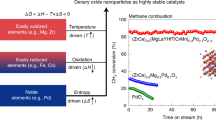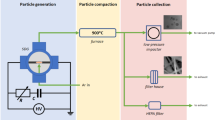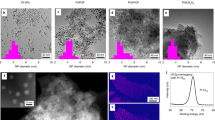Abstract
Catalysts play an important role in many industrial processes, but their use in high-temperature applications—such as energy generation through natural gas combustion, steam reforming and the partial oxidation of hydrocarbons to produce feedstock chemicals—is problematic. The need for catalytic materials that remain stable and active over long periods at high operation temperatures, often in the presence of deactivating or even poisoning compounds, presents a challenge. For example, catalytic methane combustion, which generates power with reduced greenhouse-gas and nitrogen-oxide emissions1,2,3, is limited by the availability of catalysts that are sufficiently active at low temperatures for start-up and are then able to sustain activity and mechanical integrity at flame temperatures as high as 1,300 °C. Here we use sol–gel processing in reverse microemulsions to produce discrete barium hexaaluminate nanoparticles that display excellent methane combustion activity, owing to their high surface area, high thermal stability and the ultrahigh dispersion of cerium oxide on the their surfaces. Our synthesis method provides a general route to the production of a wide range of thermally stable nanostructured composite materials with large surface-to-volume ratios4,5,6 and an ultrahigh component dispersion that gives rise to synergistic chemical and electronic effects7,8, thus paving the way to the development of catalysts suitable for high-temperature industrial applications.
This is a preview of subscription content, access via your institution
Access options
Subscribe to this journal
Receive 51 print issues and online access
$199.00 per year
only $3.90 per issue
Buy this article
- Purchase on Springer Link
- Instant access to full article PDF
Prices may be subject to local taxes which are calculated during checkout




Similar content being viewed by others
References
Pfefferle,L. D. & Pfefferle,W. C. Catalysis in combustion. Catal. Rev. Sci. Eng. 29, 219–267 (1987).
Linan,A. & Williams,F. A. Fundamental Aspects of Combustion (Oxford, New York, 1993).
Lunsford,J. H. The role of surface generated gas-phase radicals in catalysis. Langmuir 5, 12–16 (1989).
Karch,J., Birringer,R. & Gleiter,H. Ceramics ductile at low temperature. Nature 330, 556–558 (1987).
Gleiter,H. Nanocrystalline materials. Prog. Mater. Sci. 33, 223–315 (1989).
Siegel,R. W. Cluster-assembled nanophase materials. Annu. Rev. Mater. Sci. 21, 559–578 (1991).
Ying,J. Y. & Tschöpe,A. Synthesis and characterization of non-stoichiometric nanocrystalline cerium oxide-based catalysts. Chem. Eng. J. 64, 225–237 (1996).
Ying,J. Y., Tschöpe,A. & Levin,D. Synergistic effects and catalytic properties tailored by nanostructure processing. Nanostruct. Mater. 6, 237–246 (1995).
McCarty,J. G. Kinetics of PdO combustion catalysis. Catal. Today 26, 283–293 (1995).
Trimm,D. L. Materials selection and design of high temperature catalytic combustion units. Catal. Today 26, 231–238 (1995).
Berg,M. & Järås,S. G. Catalytic combustion of methane over magnesium oxide. Appl. Catal. A 114, 227–241 (1994).
Matsuura,I., Hashimoto,Y., Takayasu,O., Nitta,K. & Yoshida,Y. Heat-stable ultrafine single-crystal magnesium oxide and its character as a support material for high-temperature combustion catalysts. Appl. Catal. 74, 273–280 (1991).
Groppi,G., Belloto,M., Cristiani,C., Forzatti,P. & Villa,P. L. Preparation and characterization of hexaaluminate-based materials for catalytic combustion. Appl. Catal. A 104, 101–108 (1993).
Park,J.-G. & Cormack,A. N. Crystal/defect structures and phase stability in Ba hexaaluminates. J. Solid State Chem. 121, 278–290 (1996).
Machida,M., Eguchi,K. & Arai,H. Preparation and characterization of large surface area BHA. Bull. Chem. Soc. Jpn 61, 3659–3665 (1988).
Machida,M., Eguchi,K. & Arai,H. Catalytic properties of BaMAl11O19-α for high-temperature catalytic combustion. J. Catal. 120, 377–386 (1989).
Scherer,G. W. & Brinker,C. J. Sol-Gel Science: The Physics and Chemistry of Sol-Gel Processing (Academic, Boston, 1990).
Zwinkels,M. F. M., Järås,S. G., Menon,P. G. & Griffin,T. A. Catalytic materials for high-temperature combustion. Catal. Rev. Sci. Eng. 25, 319–358 (1993).
Acknowledgements
We thank H. H. Hwu for technical assistance and M. Frongillo for assistance with the high-resolution electron microscopy studies. This work was supported by the David and Lucile Packard Foundation.
Author information
Authors and Affiliations
Corresponding author
Rights and permissions
About this article
Cite this article
Zarur, A., Ying, J. Reverse microemulsion synthesis of nanostructured complex oxides for catalytic combustion. Nature 403, 65–67 (2000). https://doi.org/10.1038/47450
Received:
Accepted:
Issue Date:
DOI: https://doi.org/10.1038/47450
This article is cited by
-
Unraveling the Role of Sodium in Removing Oxygen from Propylene over Fe-Based Catalysts
Catalysis Letters (2024)
-
Synthesis of pyridone derivatives using 2D rod like bifunctional Fe based MOF and CuO nanocomposites as a novel heterogeneous catalyst
Scientific Reports (2023)
-
Fourier transform infrared spectroscopic studies of methane and liquefied natural gas reforming processes on Ni/CeO2 catalyst
Reaction Kinetics, Mechanisms and Catalysis (2023)
-
Synthesis and luminescence of ultrasmall CsPbBr3 nanocrystals and CsPbBr3/Cs4PbBr6 composites by one-pot method
Rare Metals (2022)
-
Denary oxide nanoparticles as highly stable catalysts for methane combustion
Nature Catalysis (2021)
Comments
By submitting a comment you agree to abide by our Terms and Community Guidelines. If you find something abusive or that does not comply with our terms or guidelines please flag it as inappropriate.



